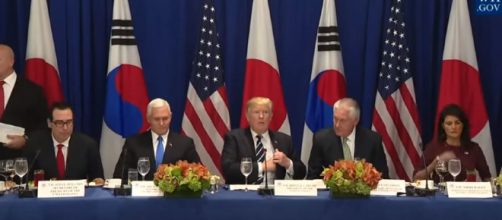Come February 9, 2018, the two Koreans, North and South Korea will be doing what no soothsayer would have ever envisaged just two months ago: They will be marching together at PyeongChang 2018 Olympic Winter Games carrying their white-and-blue "Unification Flag!" Ironically, only one person deserves to be thanked for that: President Donald Trump.
Long history short
To summarize the tortuous historical events between the two Koreans, this timeline will do justice to that:
- 1950-1953 The Korean War (over a million lives lost)
- 1960s Series of military clashes along the DMZ (De-Militarized Zone) between the two countries
- 1972 First joint statement on Korean Unification
- 1974 South Korean First Lady, Yuk Young-soo killed during an unsuccessful assassination attempt on her husband, Park Chung-hee
- 1983 Assassination attempt on Park Chung-hee's successor, President Chun Doo-hwan in Burma
- 1987 Korean Air Flight 858 was allegedly bombed by North Korea, killing all the passengers aboard
- 1988-1993 Series of improved inter-Korean relations and direct trades
- 1991 The two Koreans signed a "Basic Agreement" on reconciliation, nonaggression, and exchange cooperation
The nuclear North Korea
Pyongyang's quest for the status of a nuclear state has thrown the entire korean peninsula into a situation of perpetual discord, despite some progress that has been made to normalize relations between the two countries.
South Korea, ideally, sees a nuclear North Korea as a formidable threat. Even China and Russia--North Korea's two staunch allies--cannot easily stomach the thought of North Korea, ruled by erratic leaders, becoming a nuclear state. For the most part, it is Pyongyang's irrepressible nuclear ambition that has brought it under the radar of other nations, including the United States. President Trump has hilariously nicknamed him the 'Little Rocket Man.' With UN sanctions, the world is speaking in unison against North Korea's careless nuclear armament development and testing.
The big 'Rocket Man'
Until now, the past United States' presidents and other world leaders have always treated the North Korean issue with the carrot-and-stick approach: Slam a sanction on the country as well as assisting it with some financial aids.
But that changed as the incumbent U.S. President, Donald Trump wants to shake things up. He personally does not see any reason why a country like North Korea should be left to rule its people the way it does. He has vowed a 'Fire-and-fury' response if North Korea acts dangerously with the nuclear weapons it is developing. And that option, according to him, is still very much on the table.
Olympic games of unification
When North Korea accepted to participate in PyeongChang 2018 Winter Olympic Games in South Korea, every other process for its smooth involvement in the Games moved so fast: International Olympic Committee (IOC) welcomed the development and gladly opened its gates to as many North Korean athletes as possible.
South Korean hockey team decided to form a joint hockey team for the Olympics by absorbing some good North Korean hockey players. North Korea, for its part, is sending his second most senior official, Kim Yong-Nam to the opening ceremony as well as conveying a popular all-girl band to the venue to cheer up their national athletes.
A good development
For those of us who love peaceful reconciliations among warring factions, this is a very good development. However, some South Koreans have lambasted the move as a North Korean desperate action to create a wedge between the United States and South Korea: An issue that has already caused the newly elected South Korean President, Moon Jae-in to lose a chunk of his approval rating within weeks for kowtowing to the North Korean Supreme leader, Kim Jong-Un's wishes.


